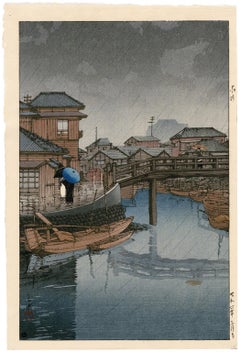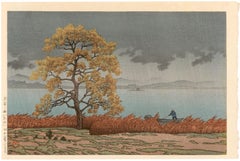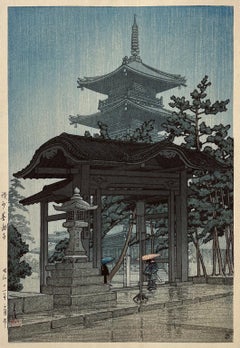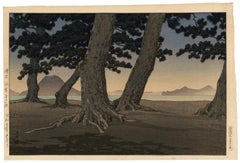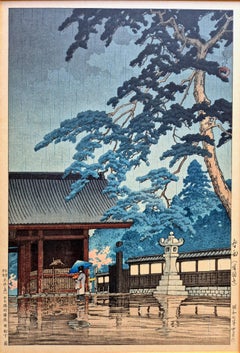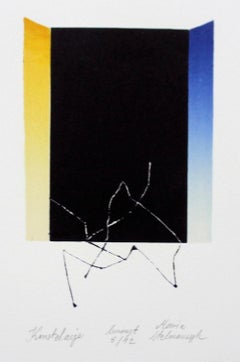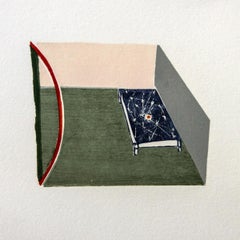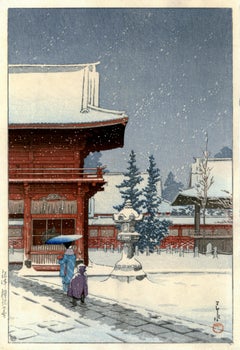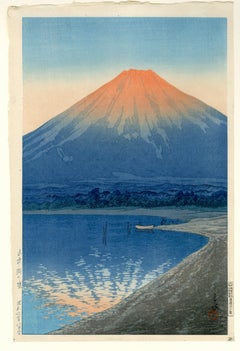Kawase Hasui Prints and Multiples
Japanese, 1883-1957
Hasui Kawase (Japanese, 1883 -1957) was an artist, one of modern Japan's most important and prolific printmakers. He was a prominent designer of the shin-hanga ("new prints") movement, whose artists depicted traditional subjects with a style influenced by Western art. Like many earlier ukiyo-e prints, Hasui's works were commonly landscapes, but displayed atmospheric effects and natural lighting.
Hasui designed approximately 620 prints over a career that spanned nearly forty years. Towards the end of his life the government recognized him as a Living National Treasure for his contribution to Japanese culture.
From youth Hasui dreamed of an art career. His maternal uncle was Kanagaki Robun (1829–94), a Japanese author and journalist, who produced the first manga magazine. Hasui went to the school of the painter Aoyagi Bokusen as a young man. He sketched from nature, copied the masters' woodblock prints, and studied brush painting with Araki Kanyu. His parents had him take on the family rope and thread wholesaling business, but its bankruptcy when he was 26 freed him to pursue art.
He approached Kiyokata Kaburagi to teach him, but Kaburagi instead encouraged him to study Western-style painting, which he did with Okada Saburōsuke for two years. Two years later he again applied as a student to Kaburagi, who this time accepted him. Kiyokata bestowed the name Hasui upon him, which can be translated as "water gushing from a spring", and derives from his elementary school combined with an ideogram of his family name.
Kawase studied ukiyo-e and Japanese style painting at the studio of Kiyokata Kaburagi. He mainly concentrated on making watercolors of actors, everyday life and landscapes, many of them published as illustrations in books and magazines in the last few years of the Meiji period and early Taishō period.
Kawase worked almost exclusively on landscape and townscape prints based on sketches and watercolors he made in Tokyo and during travels around Japan. However, his prints are not merely meishō (famous places) prints that are typical of earlier ukiyo-e masters such as Hiroshige and Katsushika Hokusai (1760-1849). Kawase's prints feature locales that are tranquil and obscure in urbanizing Japan.
Hasui Kawase's works are currently kept in several museums worldwide, including the British Museum, the Toledo Museum of Art, the Brooklyn Museum, the Indianapolis Museum of Art, the Museum of Fine Arts, Boston, the Metropolitan Museum of Art, the Portland Art Museum, the Los Angeles County Museum of Art, the University of Michigan Museum of Art, the Minneapolis Institute of Art, the Stanley Museum of Art, the Walters Art Museum, the Clark Art Institute, the Smart Museum of Art, the Nelson-Atkins Museum of Art, and the Virginia Museum of Fine Arts.to
3
9
Overall Width
to
Overall Height
to
9
1,171
919
894
818
9
7
2
6
3
5
5
4
3
2
2
2
1
1
1
1
1
1
1
1
1
1
1
1
1
9
2
1
4
Artist: Kawase Hasui
'Rain at Shinagawa, Ryoshimachi' — Showa-era Woodblock Print
By Kawase Hasui
Located in Myrtle Beach, SC
Kawase Hasui, 'Rain at Shinagawa, Ryoshimachi' from the series 'Selection of Views of the Tokaido', woodblock print, 1931. A very fine, atmospheric impression, with fresh colors; the...
Category
1930s Showa Kawase Hasui Prints and Multiples
Materials
Woodcut
'Lakeside Shower, Matsue' — Showa-era Woodblock Print
By Kawase Hasui
Located in Myrtle Beach, SC
Kawase Hasui, 'Chihan no Ame, Matsue' (Lakeside Shower, Matsue), color woodblock print, 1932. A fine, atmospheric impression, with fresh colors; the full sheet, from a postwar editio...
Category
1930s Showa Kawase Hasui Prints and Multiples
Materials
Woodcut
Zentsuji Temple in the Rain — from the series Collected Views of Japan II
By Kawase Hasui
Located in Myrtle Beach, SC
Kawase Hasui, 'Zentsuji Temple in the Rain' from the seres 'Collected Views of Japan II', color woodblock print, 1937. Signed Hasui in black ink, with the artist’s red seal Kawase, ...
Category
1930s Showa Kawase Hasui Prints and Multiples
Materials
Woodcut
'The Beach at Kaiganji in Sanuki Province' — Lifetime Impression
By Kawase Hasui
Located in Myrtle Beach, SC
Kawase Hasui, 'The Beach at Kaiganji in Sanuki Province (Sanuki Kaiganji no hama),' from the series Collected Views of Japan II, Kansai Edition (Nihon fûkei shû II Kansai hen), woodblock print, 1934. A very fine, atmospheric impression, with fresh colors; the full sheet, in excellent condition. Signed 'Hasui' with the artist’s seal 'Kawase', lower left. Published by Watanabe Shozaburo with the Watanabe ‘D’ seal indicating an early impression printed between 1931 - 1941. Stamped faintly 'Made in Japan' in the bottom center margin, verso.
Horizontal ôban; image size 9 3/8 x 14 1/4 inches (238 x 362 mm); sheet size approximately 10 5/16 x 15 1/2 inches ( 262 x 394 mm).
Collections: Art Institute of Chicago; Austrian Museum of Applied Arts (Vienna); Honolulu Museum of Art; Museum of Fine Arts, Boston; National Museum in Warsaw; University of Wisconsin-Madison.
ABOUT THE ARTIST
“I do not paint subjective impressions. My work is based on reality...I can not falsify...(but) I can simplify…I make mental impressions of the light and color at the time of sketching. While coloring the sketch, I am already imagining the effects in a woodblock print.” — Kawase Hasui
Hasui Kawase...
Category
1930s Showa Kawase Hasui Prints and Multiples
Materials
Woodcut
Kawase Hasui -- Snow at Hie Shrine, circa 1946 - 1957
By Kawase Hasui
Located in BRUCE, ACT
Kawase Hasui (Japanese, 1883-1957)
Snow at Hie Shrine, circa 1946 -1957 (dated in the publisher's seal)
Woodblock
Sheet size 37.5 x 26.0 cm (vertical oban)
Frame size 51.3 x 38.5 x 2...
Category
1940s Kawase Hasui Prints and Multiples
Materials
Woodcut
$4,823 Sale Price
30% Off
Kawase Hasui -- Spring Rain at Gokoku Temple
By Kawase Hasui
Located in BRUCE, ACT
Kawase Hasui
Spring Rain at Gokoku-ji Temple, 1932
Woodblock Print
1st Publication: 1932
Sheet size: 39 × 26 cm
Date of this edition: 1932, 1st edition
Publisher: Doi Teiichi
Note...
Category
1930s Kawase Hasui Prints and Multiples
Materials
Woodcut
$8,640 Sale Price
20% Off
Kawase Hasui -- Morning in Hirano, Lake Yamanaka (山中湖平野の朝)
By Kawase Hasui
Located in BRUCE, ACT
Kawase Hasui
Morning in Hirano, Lake Yamanaka (山中湖平野の朝), 1936
Color woodblock print
Oban
Sheet: 31 × 42 cm
Image: 28.7 × 40 cm
First edition seal: 'D' seal
Published by Watanabe Shoz...
Category
1930s Kawase Hasui Prints and Multiples
Materials
Woodcut
Kawase Hasui -- Torii Gate at Miyajima in the Inland Sea of Japan
By Kawase Hasui
Located in BRUCE, ACT
Kawase Hasui
Torii Gate at Miyajima in the Inland Sea of Japan, 1930s
First Edition
Color woodcut on Japanese paper, with the artist's red seal Sui, with margin
Sheet size 9 1/4 x 14...
Category
1930s Kawase Hasui Prints and Multiples
Materials
Woodcut
Kawase Hasui -- Rain at Yasuniwa (Nagano)
By Kawase Hasui
Located in BRUCE, ACT
Kawase Hasui
Rain at Yasuniwa (Nagano), 1946
woodcut in colours
Signed on the block, sealed, titled and dated in ink
Publisher: Shozaburo Watanabe, with his 6mm seal
The first state
...
Category
1940s Kawase Hasui Prints and Multiples
Materials
Woodcut
$3,168 Sale Price
20% Off
Related Items
Constellation - XXI Century, Contemporary Linocut & Woodcut Print, Abstract
By Maria Stelmaszczyk
Located in Warsaw, PL
MARIA STELMASZCZYK (born in 1983) Studies at the Faculty of Graphic Arts and Painting
Laboratory of Woodcut Techniques and Artistic Book at the Academy of Fine Arts Władysław Strzemi...
Category
Early 2000s Contemporary Kawase Hasui Prints and Multiples
Materials
Paper, Linocut, Woodcut
Room with a red arch - XXI Century, Contemporary Linocut Woodcut Print, Colorful
By Maria Stelmaszczyk
Located in Warsaw, PL
Maria Stelmaszczyk is a Polish artist born in 1983.
PROVENANCE
Exhibited at Katarzyna Napiorkowska Gallery.
The Gallery is a primary representative for this artist.
The Gallery o...
Category
Early 2000s Contemporary Kawase Hasui Prints and Multiples
Materials
Paper, Woodcut, Linocut
"Mine Shaft", Soviet Union: An Early 20th C. Woodcut Engraving by Abramovitz
By Albert Abramovitz
Located in Alamo, CA
This is a signed woodcut engraving entitled "Mine Shaft" created by Albert Abramovitz in 1935, after a trip to the Soviet Union. It depicts two Russian workers constructing a mine sh...
Category
1930s Kawase Hasui Prints and Multiples
Materials
Woodcut
$940 Sale Price
20% Off
H 13.38 in W 8.88 in
Winslow Homer 19th Century Woodcut Engraving "Making Hay"
By Winslow Homer
Located in Alamo, CA
This Winslow Homer woodcut engraving entitled "Making Hay", was published in Harper's Weekly in the July 6, 1872 edition. It depicts a two men hand cutting high grass on a hill. The man in the foreground is looking at a young boy and a girl (presumably his children), who are sitting on the ground with a picnic basket.
This beautiful Homer woodcut engraving is presented in a brown wood frame and a light beige fabric mat with a black inner mat. The print is in excellent condition.
There are two other Homer woodcut engravings in identical frames and mats that are listed on 1stdibs. See LU117326148332 and LU117326148272. These would make a wonderful display grouping. A discount is available for the purchase of two or all three of these prints.
This Winslow Homer engraving...
Category
1870s American Impressionist Kawase Hasui Prints and Multiples
Materials
Engraving, Woodcut
$700 Sale Price
20% Off
H 18.5 in W 22.32 in D 1.57 in
Village of Montmarte, Paris
By Shungo Sekiguchi
Located in Belgrade, MT
This piece is part of my private collection since the 1970's. It is an original color lithograph signed and numbered by the Japanese artist Shungo Sekiguchi. In 1935 Shungo Sekiguchi...
Category
Mid-20th Century Modern Kawase Hasui Prints and Multiples
Materials
Lithograph, Woodcut
Midnight Wolf: A Limited Edition Clarence Mills Signed Haida Inuit Print
Located in Alamo, CA
"Midnight Wolf" is a framed signed limited edition abstract inuit native people's work by Northwest Coast Haida artist Clarence Mills. The print depicts a st...
Category
Late 20th Century Abstract Kawase Hasui Prints and Multiples
Materials
Woodcut
$860 Sale Price
20% Off
H 26.88 in W 20.63 in D 0.88 in
Thirsty: The Appearance of a Town Geisha - a So-Called Wine-Server - in the Anse
By Taiso Yoshitoshi
Located in Fairlawn, OH
Thirsty: The Appearance of a Town Geisha - a So-Called Wine-Server - in the Ansei Era
Color woodcut, 1888
Signed; Seal: Taiso (see photo)
Plate 22 from the series "Thirty-two Aspects...
Category
1880s Showa Kawase Hasui Prints and Multiples
Materials
Woodcut
$1,800
H 14.13 in W 9.63 in
Jacob Heller “Tropical Mexico”
Located in San Francisco, CA
Fabulous cubist wood cut of a Mexican village. It is titled tropical Mexico and is by the artist Jacob Heller. Really kool sky with lines for rain and ovals for clouds.There is not m...
Category
Mid-20th Century Cubist Kawase Hasui Prints and Multiples
Materials
Woodcut
Maison Typique Doorways
Located in Houston, TX
Delightful French woodcut titled "Maison Typique", 1981. Signed and dated lower right. 66/200
Original artwork on paper displayed on a white mat with...
Category
1980s Kawase Hasui Prints and Multiples
Materials
Woodcut
San Francisco Sicilian and Italian Fishermen: A 19th C. Hand-colored Woodcut
Located in Alamo, CA
This is a framed hand-colored woodcut engraving entitled "Sicilian and Italian Fisherman's Dock - San Francisco", created by Henry François Farny ...
Category
Late 19th Century Kawase Hasui Prints and Multiples
Materials
Woodcut
$1,020 Sale Price
20% Off
H 21.13 in W 27.25 in D 1.13 in
Winslow Homer 19th Century Woodcut Engraving "The Morning Walk"
By Winslow Homer
Located in Alamo, CA
This Winslow Homer woodcut engraving entitled "The Morning Walk, Young Ladies' School Promenading the Avenue", was published in Harper's Weekly in the...
Category
1870s American Impressionist Kawase Hasui Prints and Multiples
Materials
Engraving, Woodcut
$700 Sale Price
20% Off
H 18.5 in W 22.32 in D 1.57 in
untitled ( Pikachu Pokémon )
Located in New York, NY
untitled woodcut by Kjell Otterness from the early 2000s printed in an edition of 6. Pickachu Pokémon
Category
Early 2000s Kawase Hasui Prints and Multiples
Materials
Woodcut
Previously Available Items
Snow at Nezu-Gongen Shrine (Nezu-Gongen no yuki)
By Kawase Hasui
Located in Fairlawn, OH
Snow at Nezu-Gongen Shrine
(Nezu-Gongen no yuki)
Color woodcut, 1933
Signed in the block Hasui with the red Kawase seal
(see photo)
Publisher: Watanabe, with the "J" seal, de...
Category
1930s Modern Kawase Hasui Prints and Multiples
Materials
Woodcut
Daybreak over Lake Yamanaka
By Kawase Hasui
Located in Fairlawn, OH
Daybreak over Lake Yamanaka
Color woodcut, 1931
Published by the Watanabe Color Print Co.
Watanabe seal "D" (1931-1941) See photo
Pre-war design and pre-war printing
Lake Yamanaka i...
Category
1930s Kawase Hasui Prints and Multiples
Materials
Woodcut
Kawase Hasui -- Taisho Pond Kamikochi 土高橋大正池
By Kawase Hasui
Located in BRUCE, ACT
Kawase Hasui 川瀬 巴水 (1883-1957)
Title: Taisho Pond Kamikochi 土高橋大正池
Date: Ca. 1927
First state
Oban
frame size: 49.8 x 37.5 x 2 cm
The red “Rumi” seal of the publisher in the lower r...
Category
1920s Kawase Hasui Prints and Multiples
Materials
Woodcut
'Rain at Shinagawa, Ryoshimachi' — lifetime impression
By Kawase Hasui
Located in Myrtle Beach, SC
A fine, atmospheric impression, with fresh colors; the full sheet, in excellent condition. Signed 'Hasui' with the artist’s seal 'Kawase', lower left. Published by Watanabe Shozaburo with the Watanabe 6mm round seal indicating a lifetime impression printed between 1945 - 1957. Archivally sleeved, unmatted.
Image size 14 1/4 x 9 3/8 inches (362 x 238 mm); sheet size 15 1/2 x 10 3/8 inches (391 x 264 mm).
An impression of this work is in the permanent collection of the Fine Arts Museum of San Francisco, Achenbach Foundation.
ABOUT THE ARTIST
“I do not paint subjective impressions. My work is based on reality...I can not falsify...(but) I can simplify…I make mental impressions of the light and color at the time of sketching. While coloring the sketch, I am already imagining the effects in a woodblock print.” — Kawase Hasui
Hasui Kawase (1883–1957) is the most celebrated Japanese print designer of the shin-hanga ('new prints') movement. His prints, produced under the guidance and discerning eye of his publisher, Watanabe Shozaburo, represent the modern legacy of the renowned 19th-century Ukiyo-e masters Hiroshige and Hokusai. Hasui was able to evoke the fleeting beauty of Japan during the interwar period as no other printmaker of his time could.
Hasui's work enjoyed huge popularity upon producing his first print in 1918. Watanabe recognized and developed the enormous potential of the American market, resulting in Hasui's prints achieving high prices at auctions in New York as early as the 1920s. After the Second World War, his prints became highly sought-after collectible works among the American occupying forces in Japan. Hasui designed more than 600 prints during the 40-year span of his artistic career, and in 1956, he was named a 'Living National Treasure' of Japan.
Hasui’s woodblock...
Category
1930s Showa Kawase Hasui Prints and Multiples
Materials
Woodcut
Mount Fuji, Narusawa (Late Autumn) — Lifetime Impression
By Kawase Hasui
Located in Myrtle Beach, SC
Kawase Hasui, 'Mount Fuji, Narusawa (Late Autumn)', color woodblock print, 1936. A fine impression, with fresh colors; on cream wove Japan paper, the full sheet with margins, in excellent condition. Signed 'Hasui' in black ink with the artist’s red seal 'Kawase', lower right. The 6mm circular seal of publisher Watanabe (used 1946-1957), lower left, indicating a lifetime impression. Archivally sleeved, unmatted.
Impressions of this work are held in the collections of the Art Institute of Chicago; The National Museum of Modern Art, Tokyo; and the Museum of Fine Arts Boston.
ABOUT THE IMAGE
The village of Narusawa is located in Japan’s Fuji-Hakone-Izu National Park, which was established in the same year Kawase Hasui’s “Mt. Fuji, Narusawa” image was printed. The park partially encompasses the foothills of Mt Fuji, seen here as the backdrop to a family farm as a mother and daughter perform their daily chores. A drift of late autumn clouds passes...
Category
1930s Showa Kawase Hasui Prints and Multiples
Materials
Woodcut
Kiyomizu Temple in the Snow - Woodblock Print
By Kawase Hasui
Located in Soquel, CA
Kiyomizu Temple in the Snow - Woodblock Print
A spectacular woodblock print by Hasui Kawase (Japanese, 1883-1957), depicting a serene wintery balcony with two women under umbrellas in the falling snow at the Kiyomizu Temple (Temple of Pure Waters). One of the most celebrated temples in Japan, the temple was founded in 780 on the site of the Otowa Waterfall among the wooded hills to the east of Kyoto - the temple's name based on the fall's crystalline waters.
Publisher: Doi Hangaten
Artist's seal and signature in lower right corner.
Presented in a new white mat.
Paper size: 15.63"H x 10.25"W (ôban size with raw top edge)
Mat size: 24"H x 20"W
Hasui Kawase (Japanese, 1883 -1957) was an artist, one of modern Japan's most important and prolific printmakers. He was a prominent designer of the shin-hanga ("new prints") movement, whose artists depicted traditional subjects with a style influenced by Western art. Like many earlier ukiyo-e prints, Hasui's works were commonly landscapes, but displayed atmospheric effects and natural lighting.
Hasui designed approximately 620 prints over a career that spanned nearly forty years. Towards the end of his life the government recognized him as a Living National Treasure for his contribution to Japanese culture.
From youth Hasui dreamed of an art career. His maternal uncle was Kanagaki Robun (1829–94), a Japanese author and journalist, who produced the first manga magazine. Hasui went to the school of the painter Aoyagi Bokusen as a young man. He sketched from nature, copied the masters' woodblock prints, and studied brush painting with Araki Kanyu. His parents had him take on the family rope and thread wholesaling business, but its bankruptcy when he was 26 freed him to pursue art.
He approached Kiyokata Kaburagi to teach him, but Kaburagi instead encouraged him to study Western-style painting, which he did with Okada Saburōsuke...
Category
1940s Edo Kawase Hasui Prints and Multiples
Materials
Ink, Laid Paper
Spring Evening, Ueno Toshogu Shrine - Woodblock Print with First Edition Seal
By Kawase Hasui
Located in Soquel, CA
Spring Evening, Ueno Toshogu Shrine - Woodblock Print with First Edition Seal
Woodblock print by Hasui Kawase (Japanese, 1883-1957). A crescent moon hangs above the five-story red pagoda of Kan’ei Temple on a clear spring evening in Ueno. Flowering cherry trees create a profusion of pink that adds to the beauty of the view. This 17th century temple is now part of Ueno Park in Tokyo and is an National Important Cultural Property, and one of the few original buildings that survived the Battle of Ueno in 1868.
Publisher: Watanabe Shôzaburô
First edition, with the round Watanabe seal that was in use in the late 1940s, lower left.
Edge notations can be faintly seen through the paper from verso.
Artist's seal and signature in lower right corner.
Presented in an off-white mat.
Paper size: 15.25"H x 10.5"W (ôban size with raw top edge)
Mat size: 18.5"H x 13.25"W
Hasui Kawase (Japanese, 1883 -1957) was an artist, one of modern Japan's most important and prolific printmakers. He was a prominent designer of the shin-hanga ("new prints") movement, whose artists depicted traditional subjects with a style influenced by Western art. Like many earlier ukiyo-e prints, Hasui's works were commonly landscapes, but displayed atmospheric effects and natural lighting.
Hasui designed approximately 620 prints over a career that spanned nearly forty years. Towards the end of his life the government recognized him as a Living National Treasure for his contribution to Japanese culture.
From youth Hasui dreamed of an art career. His maternal uncle was Kanagaki Robun (1829–94), a Japanese author and journalist, who produced the first manga magazine. Hasui went to the school of the painter Aoyagi Bokusen as a young man. He sketched from nature, copied the masters' woodblock prints, and studied brush painting with Araki Kanyu. His parents had him take on the family rope and thread wholesaling business, but its bankruptcy when he was 26 freed him to pursue art.
He approached Kiyokata Kaburagi to teach him, but Kaburagi instead encouraged him to study Western-style painting, which he did with Okada Saburōsuke...
Category
1940s Edo Kawase Hasui Prints and Multiples
Materials
Ink, Laid Paper
H 18.5 in W 13.25 in D 0.03 in
Kawase Hasui -- Meguro Fudo Temple 目黑不动堂
By Kawase Hasui
Located in BRUCE, ACT
Title "Meguro Fudo Temple" 目黑不动堂
Date 1931; (c1940's/50's)
Publisher Watanabe Shozaburo
Seal, Carver/Printer red 6mm (lifetime edition)
Image Size 9.5 x 14.4
Impressio...
Category
Early 20th Century Kawase Hasui Prints and Multiples
Materials
Woodcut
Moon at Magome
By Kawase Hasui
Located in Burbank, CA
"Moon at Magome," from "Twenty Views of Tokyo". In this masterful evening view, the yellow glow from a small window echoes the haunting presence of the full, yellow moon. This field ...
Category
Early 20th Century Showa Kawase Hasui Prints and Multiples
Materials
Handmade Paper, Woodcut
'Rain at Shinagawa, Ryoshimachi' — lifetime impression
By Kawase Hasui
Located in Myrtle Beach, SC
A very fine, atmospheric impression, with fresh colors; the full sheet, in excellent condition. Signed 'Hasui' with the artist’s seal 'Kawase', lower left. Published by Watanabe Shozaburo with the Watanabe 6mm round seal indicating a lifetime impression printed between 1945 - 1957.
An impression of this work is in the permanent collection of the Fine Arts Museum of San Francisco, Achenbach Foundation.
ABOUT THE ARTIST
Hasui Kawase...
Category
1930s Showa Kawase Hasui Prints and Multiples
Materials
Woodcut
Mount Fuji Seen from Tagonoura, Evening — lifetime impression
By Kawase Hasui
Located in Myrtle Beach, SC
Kawase Hasui, Tagonoura no yuu II (Mount Fuji Seen from Tagonoura, Evening), color woodblock print, 1940. A fine impression, with fresh colors; on cream wove Japan paper, the full sh...
Category
1940s Showa Kawase Hasui Prints and Multiples
Materials
Woodcut
Spring Evening at the Kintaikyo Bridge (Kintaikyo no Shunsho)
By Kawase Hasui
Located in Myrtle Beach, SC
A very fine, exceptionally well-inked impression, with fresh, vivid colors, and strong contrasts, from the original publisher’s folder, never matted, framed or exposed to sunlight; i...
Category
Mid-20th Century Showa Kawase Hasui Prints and Multiples
Materials
Woodcut
H 14.32 in W 9.44 in D 0.01 in
Kawase Hasui prints and multiples for sale on 1stDibs.
Find a wide variety of authentic Kawase Hasui prints and multiples available for sale on 1stDibs. If you’re browsing the collection of prints and multiples to introduce a pop of color in a neutral corner of your living room or bedroom, you can find work that includes elements of blue and other colors. You can also browse by medium to find art by Kawase Hasui in woodcut print and more. Not every interior allows for large Kawase Hasui prints and multiples, so small editions measuring 9 inches across are available. Customers who are interested in this artist might also find the work of and Ohara Koson. Kawase Hasui prints and multiples prices can differ depending upon medium, time period and other attributes. On 1stDibs, the price for these items starts at $1,280 and tops out at $6,000, while the average work can sell for $1,900.
Questions About Kawase Hasui Prints and Multiples
- What did Hasui Kawase do?1 Answer1stDibs ExpertJune 30, 2023Hasui Kawase made woodblock prints and was one of the most important modern Japanese artists. The woodblock printmaking genre, unique to Japan, grew out of 17th-century developments in printing and book publishing. Kawase was a prominent practitioner of the shin-hanga (“new prints”) movement, whose artists depicted traditional subjects with a style influenced by Western art. Like many earlier artists working in woodblock printmaking, Hasui primarily created richly atmospheric landscapes. They’re characterized by an emphasis on natural lighting and the artist’s effort to draw attention to the beauty of nature. Hasui created hundreds of prints over a career that spanned nearly forty years. On 1stDibs, find a range of original Japanese woodblock prints.
- Where was Kawase Hasui born?1 Answer1stDibs ExpertFebruary 17, 2023Kawase Hasui was born in Tokyo, Japan, in 1883. He was one of modern Japan's most important and prolific printmakers and a prominent designer of the shin-hanga ("new prints") movement, whose artists depicted traditional subjects with a style influenced by Western art. Shop a range of Kawase Hasui art from some of the world's top galleries on 1stDibs.
